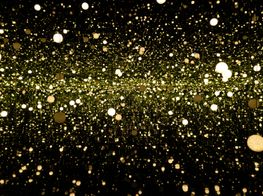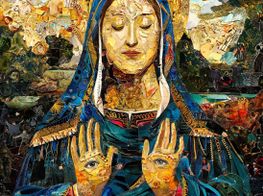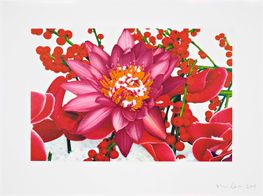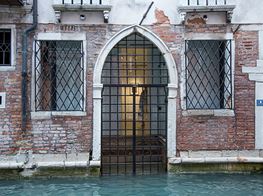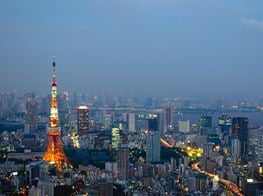Two Exhibitions: Two Collections - Japan Focus

Two private collection shows in Japan this summer revealed radically different ways to present and interpret the role of the contemporary art collector.
'Tag-Ten’: Selected Works from the Taguchi Collection
19 July to 28 September 2014,
Matsumoto City Museum of Art, Matsumoto
Matsumoto City Museum of Art presents a portion of Japanese collector Hiroshi Taguchi’s major contemporary art collection with a twist: the included works were voted for by local primary school children. In this way the show intends to capture a fresh perspective on the artworks, uninhibited by curatorial schemes or jargon.
The result is a freely presented show of important international and Japanese artists featuring an array of media without heed to chronology or style. In this exuberantly diverse set-up, Andy Warhol’s diamond dust screenprint, Double Mickey Mouse (1981) occupies the same space as Julian Opie’s fluorescent-lightbox image of Shahnoza, Pole Dancer (2006). Photography is also well represented, including works by the French artist Pierre Bismuth and German-based Candida Höfer. Seamlessly combined with these pieces are significant works representing a range of Japanese contemporary art, from the bitter irony of Aida Makoto’s large-scale painting Ash Colour Mountains (2009-11) to the mechanistic abstraction of Daisuke Ohba’s Uroboros (Spectrum) (2009) which is created using metallic acrylic on cotton.
At points within the exhibition’s free structure, vivid moments of spontaneous interaction emerge. The optical illusion of the monochrome static film piece Staging Silence (2) (2013) by Hans Op de Beeck is juxtaposed with Yuken Teruya’s neighbouring paper cut-out pieces Notice-Forest (2009). Op de Beeck’s work comprises anonymous figures’ hands constructing fantasy worlds out of everyday objects—foil bars of chocolate become glinting skyscrapers, potted plants forests; while Teruya’s work presents extremely detailed, three-dimensional trees that are cut out of ordinary shopping bags. Adjacent work by Chiharu Shiota further enhances this imaginative resonance—State of Being, Three Little Dresses (2008) features ghostly nightgowns suspended in a dense web of black threads. Together, this trio of artists gesture towards both light-hearted and sinister realms of a child-like imaginative insight.
While there are few other direct links between works, this is perhaps the beauty of this exhibition: an abdication of stringent curatorial direction as a reminder that ultimately what drives a love for art is an individual’s instinctive connection with individual artworks. Not only is this refreshing, but the exhibition signifies a generous move by a collector to encourage a new generation of art lovers.
Guess what? Hardcore Contemporary Art’s Truly a World Treasure: Selected Works from the YAGEO Foundation Collection
20 June to 25 August 2014
The National Museum of Modern Art, Tokyo
At the National Museum of Modern Art, Taiwanese collector Pierre Chen’s collection was presented in radically different fashion. The Museum curator Hosaka Kenjiro wrought a sophisticated running commentary that demanded the viewer to think critically about the work. His opening gambit: “An art museum is like a sushi restaurant where the prices are all written simply as “market price”. But don’t let that scare you off. […] Think about the relationship between the deliciousness (aesthetic value) and market price (market value) of various kinds of sushi toppings (works of art) and differences arising from culture (social values).”
So began the showcase of what is often listed as one of the top ten global contemporary art collections. Works are displayed in categories which range between descriptive and thematic, and broadly correspond to Chen’s own collecting career path. In each, the usual biographical and aesthetic description is paired with art-market-based commentary, which adds a further layer of depth.
“I concentrated on works by Taiwanese artists at the beginning for four or five years, before moving on to paintings by overseas Chinese artists including Sanyu, Zao Wou-ki , and Wu Guanzhong.” Chen explains in the catalogue interview. ”They kept me going for perhaps a decade until they began to lose lustre or spark for me. By the 1990s, I found myself increasingly drawn to western artists, the likes of Gerhard Richter, Andy Warhol, Francis Bacon, Cy Twombly, Mark Tansey, and Marc Quinn.”
Yet this show was far from an exercise in name-checking artists. Chen is known for rarely keeping pieces in storage, preferring to rotate them between his several residences in Taipei, Hong Kong or Tokyo or loan them to institutions. Having occasionally released works to make space for new acquisitions, the largely painting-based collection he now owns is uniformly of a high museum-quality standard. Major individual pieces by Rothko, de Kooning, Kiefer and Quinn were included in the exhibition alongside fascinating combinations such as Gerhard Richter’s Aunt Marianne [Tante Marianne] (1992) and Hiroshi Sugimoto’s massive oil painting of The Last Supper (1999). The soft-focus blending of Richter’s brushstrokes and its intimate scale contrasted with the crisp, sharp lines of the Sugimoto piece; and Sugimoto’s overtly religious subject matter complemented the more suggestive approach by Richter, in which the triangular compositional shape of Marianne’s body encompasses that of her child.
It is clear that for Chen, collecting is more than a devoted hobby. The YAGEO Foundation he has established together with the collection, runs a New York-based artist residency program, and has funded exhibitions at international venues including Venice, Sao Paolo, and New York’s MOMA. Collecting has been, for Chen, “a journey of enriching discovery to time past, present and future, cultural diversity, exciting creativity, and inspiration.”
Perhaps paradoxically, while the Taguchi collection show aims at a totally free process of art viewing by displaying the collection with no guiding curatorial constraints, it was the YAGEO Foundation show which imparted a greater sense of the enjoyment—and, equally, the market implications—of major art collecting.

